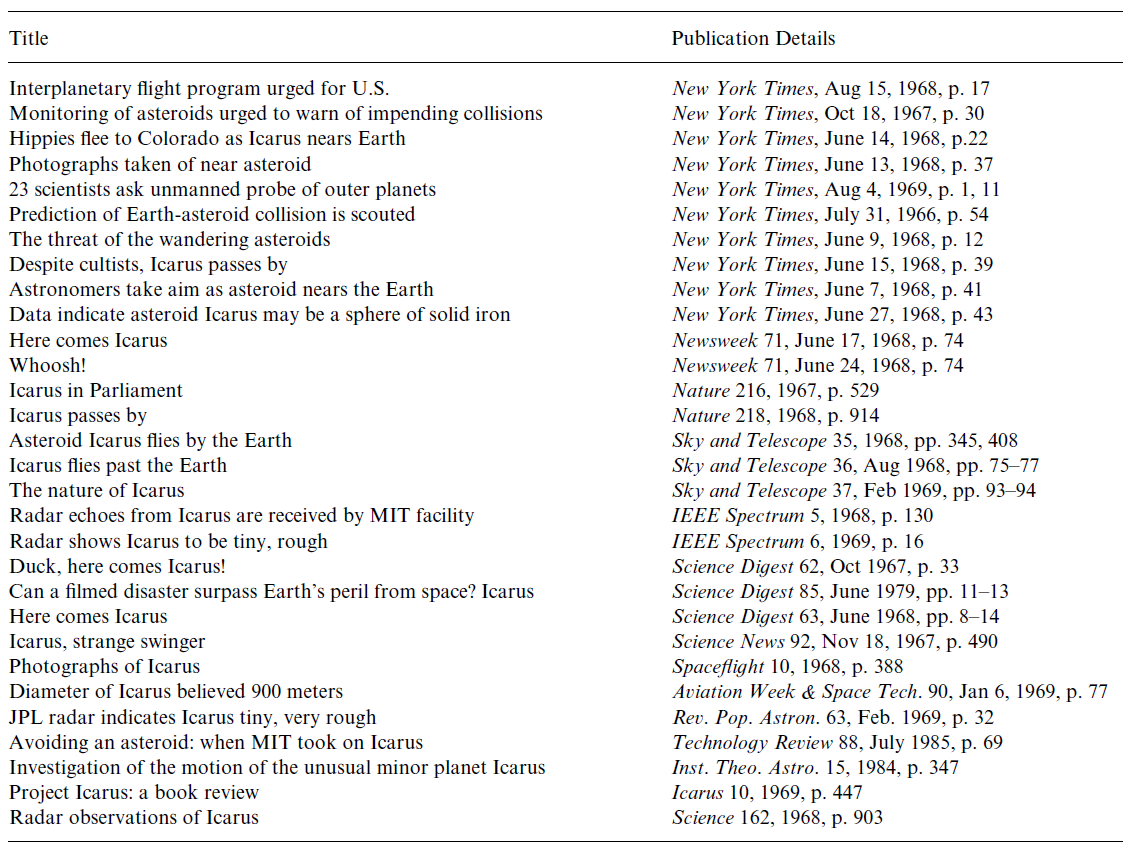Radar observations of asteroid (1566) Icarus
Introduction
We observed the kilometer-size asteroid (1566) Icarus on June 17-20, 2015 at the Arecibo Observatory. UCLA led the Arecibo observations. Observations at Goldstone were also conducted, but the Goldstone signal to noise ratio is 20-100 times lower than at Arecibo. Our findings are published in the Astronomical Journal.
Icarus is interesting for several reasons.
- It is the first near-earth Asteroid (NEA) ever detected with radar. It was observed on June 13-15, 1968 at Haystack (Pettengill et al 1969) and June 14-16, 1968 at Goldstone (Goldstein 1968).
- With a spin period of 2.3 h, Icarus is spinning near the breakup limit for a strengthless object (no tensile or shear strength). This gives it a 2/3 probability of being a binary asteroid.
- The orientation of the orbit of Icarus changes as a function of time due to general relativity (GR) and the fact that the Sun is not a perfect sphere. The change is about 10 arcseconds per century, which is easily detectable with radar. Icarus is one of about a dozen objects specifically targeted by our UCLA team to measure these effects.
Media interest in 1968 observations
The following table indicates the intense media interest in the close
approach of Icarus in 1968 (from Mahapatra et al, 1999).

Goals of 2015 observations
We are pursuing a variety of objectives related to the physical and dynamical characterization of (1566) Icarus.
We anticipate obtaining images at 15 m resolution with thorough rotational coverage, suitable for detailed 3D shape modeling. We will determine its size, shape, spin state, and multiplicity.
We anticipate measuring Arecibo-Icarus distances with a fractional precision of 1 part in 100 million. We will use these measurements in our dynamical solution to detect GR effects. See our web page for details.
Technical information
Orbital parameters are a=1.08 au, e=0.83, i=22.8 degrees.
Perihelion precession is 10"/cy (Mercury is 43"/cy).
Preliminary estimate of diameter: 1.3 km.
Lightcurve period (approximation to spin period): 2.27 h.
Estimates of rise-transit-set windows and signal-to-noise ratios (from our Arecibo observing proposal):

Status of 2015 observations
Day 1: 22 successful runs (CW, 0.1 us, 0.2 us) (out of 75 possible, transmitter problems)
Day 2: 58 successful runs (CW, 0.5 us) (out of 74 possible, transmitter problems)
Day 3: 25 successful runs (CW, 1 us) (out of 52 possible, transmitter and receiver problems)
Day 4: 7 successful runs (CW) (out of 26 possible, transmitter/zenith angle problem)
UCLA observing team

Graduate student Adam Greenberg, postdoc Ashok Verma, graduate student Oliver Bowman, and professor Jean-Luc Margot.
Collaborators at Arecibo include Patrick Taylor, Michael Nolan, Ellen Howell, and Jim Richardson.
Here is a link to additional photos of our observing trip.
References
A. H. Greenberg, J. L. Margot, A. K. Verma, P. A. Taylor, S. P. Naidu, M. Brozovic, L. A. M. Benner. Asteroid 1566 Icarus's size, shape, orbit, and Yarkovsky drift from radar observations. Astronomical Journal 153, 108, 2017.
Funding
AHG and JLM were funded in part by NASA grant NNX14AM95G and NSF grant AST-1109772.
The Arecibo Observatory is funded primarily by NSF whereas the Arecibo Planetary Radar is funded primarily by NASA. Margot has funding from NSF to test general relativity with near-Earth asteroids and funding from NASA to characterize near-Earth asteroids with radar.
The Arecibo Observatory is operated by SRI International under a cooperative agreement with the National Science Foundation (AST-1100968), and in alliance with Ana G. Méndez-Universidad Metropolitana, and the Universities Space Research Association.
The Arecibo Planetary Radar Program is supported by the National Aeronautics and Space Administration under Grant No. NNX12AF24G issued through the Near Earth Object Observations program.